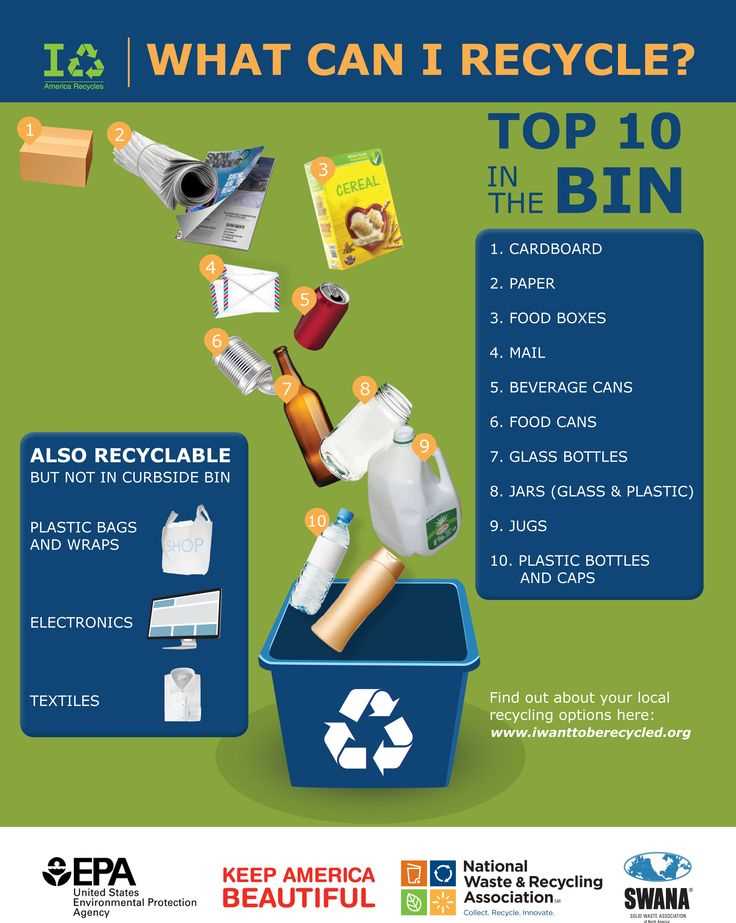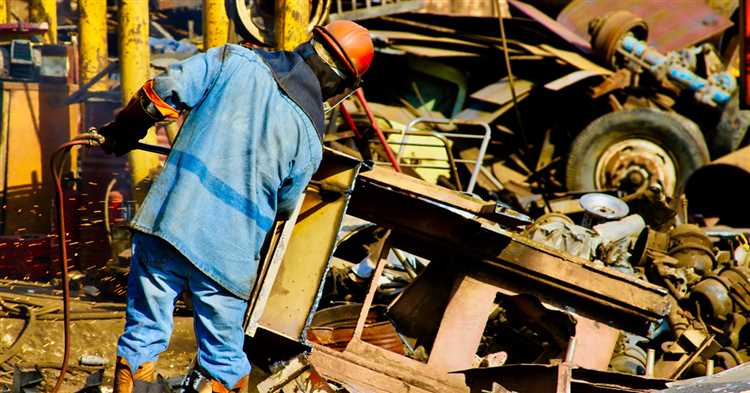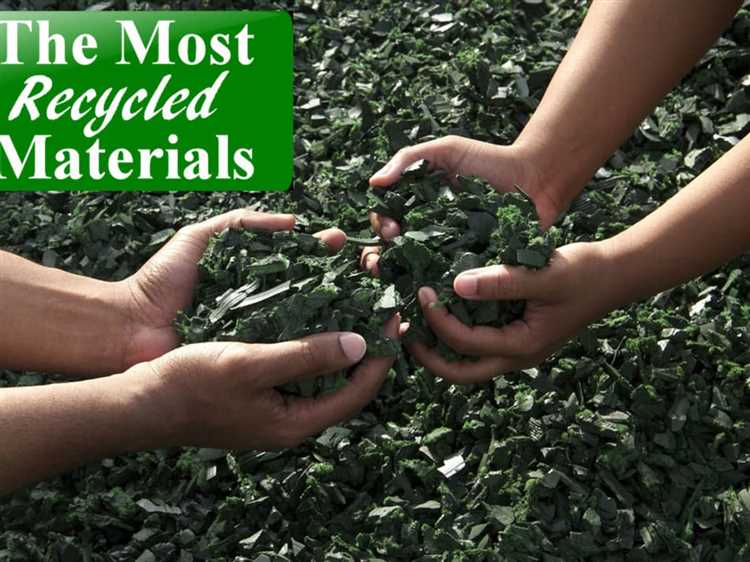
Recycling plays a crucial role in preserving our environment and reducing waste. It is one of the most effective ways to minimize the impact of human activities on the planet. But have you ever wondered what is the most recycled item in America?
While there are many materials that are recycled daily, there is one that stands out above the rest. It is a versatile material that can be found in almost every household and industry. Can you guess what it is?
The top recyclable material in America is none other than paper. Yes, that’s right! Paper is the most recycled item in the country, and for good reason. It is estimated that more than 65% of all paper produced in the United States is recycled.
Why is paper such a popular choice for recycling? Firstly, paper is made from a renewable resource – trees. By recycling paper, we can help conserve forests and reduce the demand for timber. Secondly, recycling paper saves energy, water, and reduces air pollution compared to producing new paper. Not to mention, it helps divert paper waste from landfills, which can take up valuable space and contribute to greenhouse gas emissions.
So, how does the paper recycling process work? When paper is collected for recycling, it goes through a series of steps to transform it into new paper products. The paper is sorted, cleaned, and stripped of any non-paper materials, such as staples or plastic coatings. It is then shredded into tiny pieces and mixed with water to create a pulp. The pulp is screened, de-inked, and bleached to remove any impurities. Finally, the pulp is dried, rolled into sheets, and used to make new paper products, such as newspapers, cardboard, or tissue paper.
Next time you think about recycling, remember the incredible impact that paper recycling can have on our planet. By choosing to recycle paper, we can all contribute to a greener and more sustainable future.
- Importance of Recycling
- Recycling at Home
- Recycling in Communities
- Environmental Benefits of Recycling
- 1. Conservation of Natural Resources
- 2. Reduced Energy Consumption
- 3. Decreased Pollution
- 4. Reduced Landfill Space
- The Role of Recycling in Reducing Waste
- Conclusion
- The Recycling Process: How It Works
- 1. Collection
- 2. Sorting
- 3. Processing
- 4. Manufacturing
- Top Recyclable Material: What is it?
- Ways to Increase Recycling Rates in America
- Q&A
- What is the most recycled item in America?
- Why are aluminum cans the most recycled item in America?
- How are aluminum cans recycled?
- Is recycling aluminum sustainable?
- What are some benefits of recycling aluminum cans?
Importance of Recycling
Recycling plays a crucial role in preserving the environment and ensuring a sustainable future for our planet. It is an essential practice that helps to conserve resources, reduce pollution, and minimize waste.
One of the key benefits of recycling is the conservation of natural resources. By recycling materials such as paper, plastic, glass, and metal, we can reduce the need for extracting raw materials from the earth. This helps to protect forests, preserve habitats, and conserve water and energy resources. Recycling also reduces the demand for fossil fuels, which are used in the production of new materials.
Another significant advantage of recycling is the reduction of pollution. When waste is not properly disposed of, it can lead to air and water pollution. Recycling helps to mitigate these issues by diverting waste from landfills and incineration facilities. This reduces the release of harmful gases and minimizes the pollution of our air and water resources. Additionally, recycling helps to decrease the emissions of greenhouse gases, which contribute to climate change.
Furthermore, recycling plays a vital role in reducing waste. By recycling, we can divert materials from the waste stream and give them a second life. This reduces the amount of trash that ends up in landfills, preventing the accumulation of harmful substances and toxins in the environment. Additionally, recycling helps to conserve landfill space, which is becoming increasingly scarce.
Recycling at Home
Individuals can contribute to recycling efforts by practicing recycling at home. This can be done by separating recyclable materials from general waste and placing them in designated recycling bins. Common items that can be recycled include paper, cardboard, plastic bottles, aluminum cans, and glass containers. By recycling these items, we can help conserve resources, reduce pollution, and decrease waste.
Recycling in Communities
Communities play an important role in promoting and supporting recycling initiatives. They can implement curbside recycling programs, provide recycling bins in public spaces, and educate residents about the importance of recycling. Furthermore, communities can establish partnerships with recycling centers and facilities to ensure that recyclable materials are properly processed and turned into new products.
In conclusion, recycling is of utmost importance for the well-being of our planet. By conserving resources, reducing pollution, and minimizing waste, recycling helps to create a more sustainable future for generations to come.
Environmental Benefits of Recycling
Recycling plays a crucial role in reducing the environmental impact of waste and conserving natural resources. By recycling, we can minimize the amount of waste that ends up in landfills and incinerators, which contributes to pollution and greenhouse gas emissions.
1. Conservation of Natural Resources
Recycling helps conserve valuable natural resources such as trees, minerals, and water. By reusing materials instead of extracting new ones, we can reduce the need for deforestation, mining, and excessive water consumption. For example, recycling one ton of paper can save around 17 trees and large amounts of water and energy.
2. Reduced Energy Consumption
Producing goods from recycled materials often requires less energy compared to manufacturing from raw materials. For example, manufacturing aluminum from recycled aluminum cans uses 95% less energy than extracting it from bauxite ore. By reducing energy consumption, recycling helps decrease dependence on fossil fuels and lowers carbon emissions.
3. Decreased Pollution
Recycling reduces pollution by minimizing the need for extracting raw materials through mining, drilling, and logging. These activities can release harmful pollutants, such as sulfur dioxide, nitrogen oxides, and greenhouse gases, into the air, water, and soil. Recycling also reduces the pollution associated with waste disposal, including methane emissions from decomposing organic waste in landfills.
4. Reduced Landfill Space

Landfills take up valuable land and can contaminate soil and groundwater if not properly managed. By recycling, we can divert materials from landfills and extend their lifespan. This helps conserve land resources and mitigates the negative environmental impacts of landfilling, such as soil and water pollution and greenhouse gas emissions.
- Prevents Water Pollution: Recycling decreases the need for extracting raw materials, which can involve processes that lead to water pollution, such as chemical spills and wastewater discharges.
- Preserves Wildlife Habitats: By reducing the demand for new materials, recycling helps protect natural habitats and preserves biodiversity.
- Reduces Greenhouse Gas Emissions: Recycling reduces the need for energy-intensive manufacturing processes and prevents the release of greenhouse gases, which contribute to climate change.
In conclusion, recycling provides numerous environmental benefits, including the conservation of natural resources, reduced energy consumption, decreased pollution, and the efficient use of landfill space. By actively participating in recycling efforts, we can contribute to a more sustainable and eco-friendly future.
The Role of Recycling in Reducing Waste
Recycling plays a crucial role in reducing waste and minimizing the negative impacts of excessive waste disposal. By recycling materials such as paper, plastic, glass, and metal, we can significantly reduce the amount of waste that ends up in landfills or incinerators.
Firstly, recycling helps conserve natural resources. When we recycle materials, we reduce the need to extract and process raw materials from the environment. For example, recycling one ton of paper can save 17 trees, 7,000 gallons of water, and 380 gallons of oil. By reusing these materials, we can mitigate the depletion of natural resources and protect the ecosystems they come from.
Secondly, recycling reduces energy consumption and greenhouse gas emissions. The extraction, transportation, and processing of raw materials require significant energy inputs, which often rely on fossil fuels. By recycling materials, we can minimize the demand for new materials and the associated energy-intensive processes. As a result, we can reduce greenhouse gas emissions and combat climate change.
Furthermore, recycling helps create a circular economy and supports local communities. When we recycle materials, they can be converted into new products. This process promotes resource efficiency and reduces the dependence on imported goods. Additionally, recycling generates jobs in waste management, recycling facilities, and manufacturing industries, contributing to local economies and employment opportunities.
Conclusion

Overall, recycling plays a vital role in reducing waste and embracing sustainable practices. It conserves natural resources, reduces energy consumption and greenhouse gas emissions, and fosters a circular economy. Recycling should be seen as an integral part of waste management and an essential step towards a greener, more sustainable future.
The Recycling Process: How It Works
Recycling is the process of converting waste materials into new products. It is an essential step towards reducing waste and conserving resources. The recycling process involves several steps:
1. Collection
The first step in the recycling process is the collection of recyclable materials. This can be done through various methods, such as curbside collection, drop-off centers, or recycling bins in public places. Recycling programs aim to make it convenient for people to dispose of their recyclable items.
2. Sorting
Once collected, the recyclable materials are sorted based on their type and composition. This is done to ensure that each material can be recycled properly. Sorting can be done manually or using automated machines. The materials are grouped into categories such as paper, plastic, glass, metal, and organic waste.
3. Processing
After sorting, the recyclable materials undergo processing to prepare them for recycling. This step involves cleaning, shredding, crushing, or melting the materials depending on their type. The goal is to break down the materials into smaller pieces that can be easily transformed into new products.
4. Manufacturing
Once the recyclable materials have been processed, they are ready to be used as raw materials for manufacturing new products. For example, recycled paper can be used to make new paper products, recycled plastic can be used to produce new plastic items, and recycled metal can be used in the production of metal goods. The manufacturing process may involve further processing or combining the recycled materials with other components.
It is important to note that not all materials can be recycled infinitely. The quality of recycled materials may degrade over time, leading to a decrease in their recyclability. Therefore, it is crucial to minimize waste and choose products made from recycled materials whenever possible.
Top Recyclable Material: What is it?
When it comes to recycling, there is one material that stands out as the most recycled item in America: paper. Paper products such as newspapers, magazines, cardboard boxes, and office paper are among the most widely recycled materials in the country.
There are several reasons why paper is the top recyclable material. Firstly, paper is made from wood pulp, which is a renewable resource. By recycling paper, we reduce the need for deforestation and the destruction of natural habitats.
Secondly, recycling paper helps to conserve energy. Producing paper from recycled materials uses significantly less energy compared to making paper from virgin fibers. In fact, recycling one ton of paper saves around 4,100 kilowatt-hours of electricity – enough to power the average American home for six months!
Moreover, recycling paper helps to reduce greenhouse gas emissions. When paper decomposes in landfills, it releases methane, a potent greenhouse gas. By recycling paper, we divert it from landfills and prevent the release of methane into the atmosphere.
Not only is paper the most recycled material, but it is also one of the easiest to recycle. Most communities accept paper in their curbside recycling programs, making it convenient for individuals to participate in the recycling process.
So, the next time you finish reading a book or receive a package in a cardboard box, remember to recycle it. By recycling paper, you are contributing to the circular economy, conserving resources, and reducing your environmental impact.
Remember, every small act of recycling counts!
Ways to Increase Recycling Rates in America

Increasing recycling rates in America is crucial in order to reduce waste and promote a more sustainable future. Here are some effective ways to achieve this:
1. Education and Awareness: Promote education and raise awareness about the importance of recycling among individuals and communities. This can be done through school programs, public campaigns, and informative articles and videos.
2. Improved Recycling Infrastructure: Invest in the development and improvement of recycling infrastructure across the country. This includes increasing the number of recycling bins in public places, implementing efficient collection systems, and expanding recycling facilities.
3. Incentives: Offer incentives to individuals and businesses for recycling. This can be in the form of tax benefits, discounts on products or services, or rewards programs for recycling efforts.
4. Recycling Education in Schools: Incorporate recycling education into school curricula from an early age. Teach children about the importance of recycling, how to properly sort recyclable materials, and the environmental benefits of recycling.
5. Public-Private Partnerships: Foster partnerships between the government, private sector, and non-profit organizations to work together in promoting recycling initiatives. This collaboration can help fund recycling programs and projects, share resources, and increase overall recycling rates.
6. Expanded Recycling Programs: Implement and expand recycling programs in public spaces, workplaces, and events. Provide easy access to recycling bins and clearly label them for different types of recyclable materials.
7. Innovation and Technology: Encourage the development and adoption of innovative recycling technologies that can make the recycling process more efficient, cost-effective, and sustainable. This can include advancements in recycling machinery, sorting techniques, and recycling of new materials.
8. Reduce and Reuse: Promote the “reduce and reuse” concept to minimize waste generation. Encourage individuals and businesses to purchase reusable products, avoid single-use items, and find creative ways to repurpose materials instead of throwing them away.
9. Composting: Encourage composting as an alternative to throwing organic waste into landfills. Educate individuals about the benefits of composting and provide resources and guidance on how to start composting at home or in community gardens.
10. Mandatory Recycling Laws: Implement and enforce mandatory recycling laws at the state and local levels. These laws can require individuals and businesses to recycle certain materials, provide penalties for non-compliance, and help increase recycling rates.
By implementing these strategies, America can take significant steps towards increasing recycling rates and creating a more sustainable future.
Q&A
What is the most recycled item in America?
The most recycled item in America is aluminum cans.
Why are aluminum cans the most recycled item in America?
Aluminum cans are the most recycled item in America because they are lightweight, easy to recycle, and have a high market value.
How are aluminum cans recycled?
Aluminum cans are collected from recycling bins or recycling centers, then they are sorted, cleaned, and shredded into small pieces. The shredded aluminum is melted and purified, and then it is formed into new aluminum cans or other aluminum products.
Is recycling aluminum sustainable?
Yes, recycling aluminum is sustainable because it can be recycled indefinitely without losing its quality. Recycling aluminum saves energy, reduces the need for mining raw materials, and helps to reduce waste.
What are some benefits of recycling aluminum cans?
There are several benefits of recycling aluminum cans. It conserves natural resources, saves energy, reduces greenhouse gas emissions, reduces landfill waste, and helps create jobs in the recycling industry.